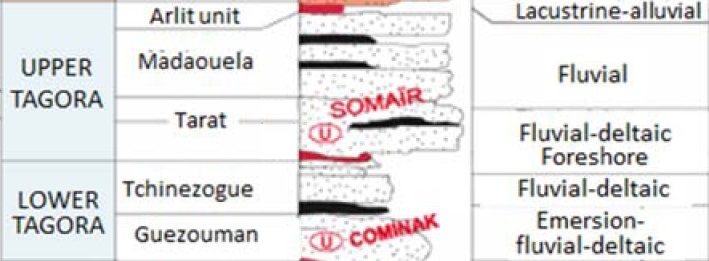Tagora Gr
Type Locality and Naming
Joulia (1959) emend. Claret & Tempère (1968). Comprises the upward succession of the Guezouman Fm, Tchinezogue Fm, Tarat Fm and Madaouela Fm (and Arlit Fm at top, depending upon usage).
References: Joulia, 1959; Bigotte & Obelianne, 1968; Claret & Tempère, 1968; Valsardieu, 1971; Fabre et al., 1983; de Rouvre, 1984, 1985, 1988; Fabre, 2005; Wagani et al., 2011; Billon et al., 2016; Sani, 2021a, 2021b.
Synonym: Série de Tagora
Lithology and Thickness
See Figure; and the individual formations for details. Characterized by fluvio-deltaic to continental shelf deposits. Joulia (1959) distinguishes two sets in this Group separated by an eroded surface and subdivided into formations as follows from top to bottom (Fig. 7-118):
- Upper argillaceous (Joulia, 1959) or Madaouela Fm
- Sandstone of the Tarat Fm
- (discontinuity),
- Argillaceous (Tchinezogue Fm ).
- Sandstone (Guezouman Fm ) with locally at the base, the Téléflak conglomerate Member.
The geologists of the CEA add, at the top, the Arlit Fm.
[Figure. Lithostratigraphy of the Tagora Group in the Tim Mersoï Sub-Basin also shows the horizons mined for their uranium content.]
Relationships and Distribution
Lower contact
Transgressive onto the Terada Gr / Talak Fm / Tim Mersoï Fm.
Upper contact
Overlain by the Izégouandane Gr, which starts with the Izégouande Fm.
Regional extent
GeoJSON
Fossils
Plants (de Rouvre, 1984, 1985, 1988). See individual formations for details.
Age
Depositional setting
This group corresponds, after a phase of erosion which has carved out paleovalleys in the substratum, to two sandy fluvio-deltaic events ( Guezouman Fm, Tarat Fm ) evolving towards more characteristic marine deposits.
Additional Information
